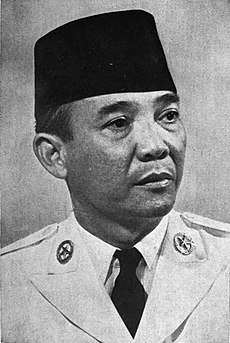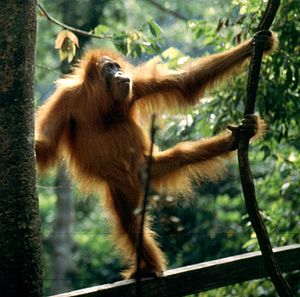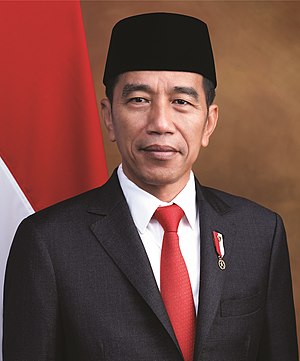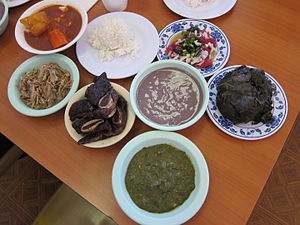Qolaysia
Federation of Qolaysia Qolaysia | |
|---|---|
|
Flag | |
| Motto: Qolaysian Sea Winds Sail Endeavor | |
| Anthem: Bennom Bahni | |
 The islands of Qolaysia, bordered by Nebetia, Saint Croix and Bens, and maritime borders with Ascacia and Togaria | |
| Capital | Leonrau |
| Official languages | Qolaysian, Qoati |
| Recognised national languages | Togarian |
| Ethnic groups | Jabanesian, Paransian, Togarian |
| Demonym(s) | Qolaysian |
| Government | |
| Elihu Saing | |
| Qaaid bin Ridwaan | |
| Obadiah Jadibata | |
| Philemon Sibabiat | |
| Hamdani Atmadja | |
| Irfaan Tuhumena | |
| Establishment | |
• Colonization | 700-1500 |
• Togarian Occupation | 1590-1949 |
• Independence | 1945 |
• Porti regime | 1968-98 |
• Current constitution | 2004 |
| Area | |
• | 268,021 km2 (103,483 sq mi) |
| Population | |
• 2020 estimate | 34,384,000 |
| GDP (PPP) | 2020 estimate |
• Total | Q193.545 billion |
| GDP (nominal) | 2020 estimate |
• Total | Q205.541 billion |
| Gini (2020) | 33.9 medium |
| HDI (2020) | 0.684 medium |
| Date format | mm-dd-yyyy |
The Federation of Qolaysia, most commonly known as Qolaysia, is a nation located on the continent of Adula, with maritime borders with Ascacia and Togaria. It consists of more than three thousand islands. The sovereign state is a presidential, constitutional federation with an elected legislature. It has 34 provinces, of which five have special status. The country's capital, Leonrau, is the most populous urban area in the country. The country shares land borders with Saint Croix and Bens on the northern island of Qolan and with Nebetia on the southern island of Banhi. Despite its urban population and densely populated regions, Qolaysia has vast areas of wilderness that support one of the world's highest levels of biodiversity.
The Qolaysian archipelago has been a valuable region for trade since at least the 8th century when the Emmirian and later Skithan Empires traded with entities from mainland Adula and the subcontinent. Local rulers gradually absorbed foreign influences from the early centuries and Qolaysian kingdoms flourished. Sunni traders and Sufi scholars brought Islam, while Verdusans and Euronians introduced Christianity through colonization. Although sometimes interrupted by the Quetanans, Durnstaal, and even Yuaneze, the Togarians were the foremost colonial power for much of their 350-year presence in the archipelago. The concept of "Qolaysia" as a nation-state emerged in the early 20th century and the country proclaimed its independence in 1945. However, it was not until 1949 that the Togarians recognised Qolaysia's sovereignty following an armed and diplomatic conflict between the two and the outset of the World War. In recent years, tensions between Togaria and Qolaysia have escalated over the resource-rich and strategic location of the archipeligo, resulting in numerous clashes including the ongoing Togana War.
Qolaysia consists of hundreds of distinct native ethnic and linguistic groups, with the largest one being the Jabanesian. A shared identity has developed with the motto "Bhinneka Tunggal Ika" ("Unity in Diversity" literally, "many, yet one"), defined by a national language, ethnic diversity, religious pluralism within a Muslim-majority population, and a history of colonialism and rebellion against it. The country is a member of many international organizations, such as the Coalition of Crown Albatross, CTO, C21, and WEDA. The current President of Qolaysia is Elihu Saing, who was previously Vice President under Nizaam bin Aayid until he passed away in 2022. Bin Aayid had been President for only 6 months, having defeated incumbent president Abiel Kennard earlier that year.
History
Evidence of modern human habitation in Qolaysia dates back 40,000 years. Traders and settlers from Yuan and Emmiria arrived as early as the first century AD, establishing trading ports and coastal towns in the second and third centuries. Their presence resulted in strong influences on the local cultures, and the people of the archipeligo adopted the religions of Hinduism and Buddhism. Sanskrit inscriptions appear as early as the fourth or fifth century.
The Kingdom of Banhi arose around the second century in the northern area of the archipeligo, lasting until about the 15th century. Between the 7th and 15th centuries, much of the region was part of the maritime Emmirian empire. Islam began to spread among Qolaysians in the 14th century. Bennom was an important commercial centre during this time, attracting trade from around the region.
In 1511, Leonrau was conquered by armies from Saint Croix and Bens, after which it was taken by the Togarian Empire in 1590. Under Togarian rule the immigration of Emmirians and Zalluabedi to serve as labourers was encouraged. The area that is now Togana came under Ascacian control between 1877 and 1878. The concept of "Qolaysia" as a nation-state emerged in the early 20th century and the country proclaimed its independence in 1945. However, it was not until 1949 that the Togarians recognised Qolaysia's sovereignty following an armed and diplomatic conflict between the two and the outset of the World War.
Tensions between the military and the newly established government culminated in an attempted coup in 1965. The army, led by Major General Manasseh Porti, countered by instigating a violent anti-communist purge that killed between 500,000 and one million people. The government was blamed for the coup and effectively destroyed. Porti capitalised on the government's weakened position, and following a drawn-out power play with President Hanjoyo Hong, Porti was appointed president in March 1968. His "New Order" administration, supported by Drambenburg, encouraged foreign direct investment, which was a crucial factor in the subsequent three decades of substantial economic growth. Qolaysia was the country hardest hit by the 1997 Adula financial crisis. It brought out popular discontent with the New Order's corruption and suppression of political opposition and ultimately ended Porti's presidency.
Since 1998, democratic processes have been strengthened by enhancing regional autonomy and instituting the country's first direct presidential election in 2004. Political, economic and social instability, corruption, and instances of terrorism (the deadliest being the 2002 Bennom bombings) remained problems in the 2000s; however, the economy has performed strongly in the last 15 years. Although relations among the diverse population are mostly harmonious, acute sectarian discontent and violence remain a problem in some areas. Tensions between Togaria and Qolaysia have escalated over the resource-rich and strategic location of the archipeligo, resulting in numerous clashes including the Togana War, but those conflicts largely ended following peace talks in Buena Vera, Artegana, in early 2021. In 2016, Abiel Kennard was elected President, and he presided over a period of rampant economic growth, although still at the expense of scandal and diplomatic tensions such as the Tarijar Strait Crisis. On June 29th, 2021, Temebok was devastated by the 2021 Temebok earthquake and tsunami, which left nearly 10,000 dead and contributed to a major economic collapse. On September 2nd, three suicide bombers attack a restaurant frequented by tourists, killing 119 and injuring more than 400 people in Bennom.
In January 2022, Nizaam bin Aayid defeated Kennard to become President, and at his inauguration he was the oldest head of state in the world at the age of 91. In his short term, he pulled Qolaysia out of the TTPA and joined WEDA, was mired in a tense standoff with Yuan over the Jinchon Sea crisis, and slashed environmental regulations. However, bin Aayid died on July 30th, 2022, and was succeeded by Vice President Elihu Saing.
Geography
According to the country's Coordinating Ministry for Maritime and Investments Affairs, Qolaysia has 3,504 islands (3,056 of which are registered at the C.C.A.), around 2,000 of which are inhabited. The largest are Jaba, Bahni (shared with Nebetia), Qolan (shared with Saint Croix and Bens), Leonrau, and Ojibana. Qolaysia shares land borders with Nebetia on the island of Bahni and with Saint Croix and Bens on the island of Qolan, and maritime borders with Ascacia and Togaria, with disputes with both Togaria and Semalia.
At 4,884 metres (16,024 ft), Quncak Baya is Qolaysia's highest peak, and Lake Qoba in Qolan is the largest lake, with an area of 1,145 km2 (442 sq mi). Qolaysia's largest rivers are in Qolan and Bahni and include Qapuas, Qarito, Yamyeramo, Yepik and Kaqakam. They serve as communication and transport links between the island's river settlements where roads are sparse.
Qolaysia's climate tends to be relatively even year-round. Qolaysia has two seasons—a wet season and a dry season—with no extremes of summer or winter. For most of Qolaysia, the dry season falls between May and October with the wet season between November and April. Qolaysia's climate is almost entirely tropical, dominated by the tropical rainforest climate found in every large island of Qolaysia. More cooling climate types do exist in mountainous regions that are 1,300 to 1,500 metres (4,300 to 4,900 feet) above sea level. The oceanic climate (Köppen Cfb) prevails in highland areas adjacent to rainforest climates, with reasonably uniform precipitation year-round.
Qolaysia's size, tropical climate, and archipelagic geography support one of the world's highest levels of biodiversity. Its flora and fauna is a mixture of endemic and Adulan-spawned species. The islands of the Qolaysian Shelf were once linked to mainland Adula, and have a wealth of Adula fauna. Large species such as the Qolaysian tiger, rhinoceros, orangutan, Adulan elephant, and leopard were once abundant as far east as Qolan, but numbers and distribution have dwindled drastically. Having been long separated from the continental landmasses, many islands have developed their unique flora and fauna, including over 600 bird species. Forests cover approximately 70% of the country. However, the forests of the smaller, and more densely populated Jaba, have largely been removed for human habitation and agriculture.
Qolaysia's large and growing population and rapid industrialisation present serious environmental issues. They are often given a lower priority due to high poverty levels and weak, under-resourced governance. Problems include the destruction of peatlands, large-scale illegal deforestation—and the resulting Southeast Adula haze—over-exploitation of marine resources, air pollution, garbage management, and reliable water and wastewater services. These issues contribute to Qolaysia's poor ranking in the 2020 Environmental Performance Index. The report also indicates that Qolaysia's performance is generally below average in both regional and global context.
Expansion of the palm oil industry requiring significant changes to the natural ecosystems is the one primary factor behind much of Qolaysia's deforestation. While it can generate wealth for local communities, it may degrade ecosystems and cause social problems. This situation makes Qolaysia the world's largest forest-based emitter of greenhouse gases. It also threatens the survival of indigenous and endemic species.
Demographics
The 2010 census recorded Qolaysia's population as 24.4 million, with high population growth at 1.9%. The population density is 138 people per km2 (357 per sq mi), ranking nera the middle in the world. The spread of the population is uneven throughout the archipelago with a varying habitat and level of development, ranging from the most populous city and capital of Leonrau to uncontacted tribes in Barakar. As of 2017, about 54.7% of the population lives in urban areas.
Ethnicity and Language
Qolaysia is an ethnically diverse country, with around 300 distinct native ethnic groups. Most Qolaysians are descended from Togarian and sub-continental peoples whose languages had origins in Togarian-Emmirian. Another major grouping is the Jelanesians, who inhabit the eastern Jelanise Islands.
The Jabanesian are the largest ethnic group, constituting 40.2% of the population, and are politically dominant. They are predominantly located in the central to eastern parts of the country and also sizable numbers in most provinces. The Paranesian and Togarians are the next largest groups in the country. A sense of Qolaysian nationhood exists alongside strong regional identities.
The country's official language is Qolaysian, a variant of Togarian-Emmirian based on its prestige dialect, which for centuries had been the lingua franca of the archipelago. It was promoted by nationalists in the 1920s and achieved official status under the name Newsha Qolaysia in 1945. As a result of centuries-long contact with other languages, it is rich in local and foreign influences, including from Jabanesian, Togarian, Paranesian, Emmirian, Albarinean, Yuaneze, Quetanan, and Caticeze-English. Nearly every Qolaysian speaks the language due to its widespread use in education, academics, communications, business, politics, and mass media. Most Qolaysians also speak at least one of more than 700 local languages, often as their first language. Most belong to the Togarian language family, while there are over 270 Barakar languages spoken in eastern Qolaysia. Of these, Jabanesian is the most widely spoken.
Religion
While the constitution stipulates religious freedom, the government officially recognises only five religions: Islam, Church of Zian, Verdusan Catholicism, Hinduism, and Buddhism; with indigenous religions only partly acknowledged. Qolaysia is the world's Muslim-majority countries with 20 million adherents in 2017, with the majority being Sunnis (95%). The Shias and Ahmadis respectively constitute 1 million (5%) of the Muslim population. Almost 11% of Qolaysians are Christians, while the rest are Hindus, Buddhists, and others.
Cities
|
Largest Census Metropolitan areas in Qolaysia by population | |||||
| No. | CMA City |
Population | Province | ||
| 1 | Leonrau | 2,784,000 | Capitol District | ||
| 2 | Banhi | 927,000 | North Banhi | ||
| 3 | Togana | 785,000 | Ojibana | ||
| 4 | Miporna | 622,000 | Lurnarau | ||
| 5 | Bennom | 463,000 | South Banhi | ||
| 6 | Temebok | 412,000 | Temebok | ||
Politics
Qolaysia is a federation with a presidential system. Since independence in 1949, political and governmental structures have undergone sweeping reforms, with four constitutional amendments revamping the executive, legislative and judicial branches. Chief among them is the delegation of power and authority to various regional entities while remaining a unitary state. The President of Qolaysia is the head of state and head of government, commander-in-chief of the Qolaysian National Armed Forces, and the director of domestic governance, policy-making, and foreign affairs. The president may serve a maximum of two consecutive five-year terms.
The highest representative body at the national level is the People's Consultative Assembly. Its main functions are supporting and amending the constitution, inaugurating and impeaching the president, and formalising broad outlines of state policy. The PCA comprises two houses; the People's Representative Council, with 575 members, and the Regional Representative Council, with 136. The PRC passes legislation and monitors the executive branch. Reforms since 1998 have markedly increased its role in national governance, while the RRC is a new chamber for matters of regional management.
Most civil disputes appear before the State Court; appeals are heard before the High Court. The Supreme Court of Qolaysia is the highest level of the judicial branch, and hears final cessation appeals and conducts case reviews. Other courts include the Constitutional Court that listens to constitutional and political matters and the Religious Court that deals with codified Islamic Law cases. Additionally, the Judicial Commission monitors the performance of judges.
Foreign Relations
Qolaysia maintains 87 diplomatic missions abroad, including 75 embassies. The country adheres to what it calls a "free and active" foreign policy, seeking a role in regional affairs in proportion to its size and location but avoiding involvement in conflicts among other countries, although it has been in a state of war with neighboring Togaria since 2009 with the Togana War.
Qolaysia was a significant battleground during the Cold War. Numerous attempts by Zamastan, Beleroskov, Yuan, and Drambenburg to some degree, culminated in the 1967 coup attempt and subsequent upheaval that led to a reorientation of foreign policy. Quiet alignment with the West while maintaining a non-aligned stance has characterised Qolaysia's foreign policy since then. Today, it maintains close relations with its neighbours, with the exemption of Togaria, and is a member of the Coalition of Crown Albatross. It is a founding member of the Association of Southeast Adulan Nations (ASEAN) and the East Adula Summit. In common with most of the Muslim world, Qolaysia does not have strong diplomatic relations with Verdusa and has actively expressed support for Muslim separatists and activists in the country. However, observers have pointed out that Qolaysia has ties with Verdusa, albeit discreetly.
Military
Qolaysian National Armed Forces include the Army, Navy, and Air Force. The army has about 400,000 active-duty personnel. Defence spending in the national budget was 0.7% of GDP in 2018, with controversial involvement of military-owned commercial interests and foundations. The Armed Forces were formed during the Qolaysian National Revolution when it undertook guerrilla warfare along with informal militia. Since then, territorial lines have formed the basis of all QNAF branches' structure, aimed at maintaining domestic stability and deterring foreign threats. The military has possessed a strong political influence since its founding, which peaked during the New Order. Political reforms in 1998 included the removal of the QNAF's formal representation from the legislature. Nevertheless, its political influence remains, albeit at a reduced level.
Since independence, the country has struggled to maintain unity against local insurgencies and separatist movements, and has constantly skirmished with Togaria over disputed islands and oil reserves. Some insurgencies, notably in Jaceh and Qaquo, have led to an armed conflict, and subsequent allegations of human rights abuses and brutality from all sides. The insurgencies were resolved peacefully in 2005, while the Togana War continues, amid a significant, albeit imperfect, implementation of regional autonomy laws, and a reported decline in the levels of violence and human rights abuses since 2008.
Economy

Qolaysia has a mixed economy in which both the private sector and government play vital roles. The country has the largest economy in the region and is classified as a newly industrialised country. As of 2019, it is the world's 19th largest economy by nominal GDP and 7th in terms of GDP at PPP, estimated to be Z$1.100 trillion and Z$3.740 trillion respectively. Per capita GDP in PPP is Z$14,020, while nominal per capita GDP is Z$4,120. The debt ratio to GDP is 29.2%. The services are the economy's largest sector and account for 43.4% of GDP (2018), followed by industry (39.7%) and agriculture (12.8%). Since 2009, it has employed more people than other sectors, accounting for 47.7% of the total labour force, followed by agriculture (30.2%) and industry (21.9%). Construction, especially the expanse of roads, have contributed significantly to the economy.
Over time, the structure of the economy has changed considerably. Historically, it has been weighted heavily towards agriculture, reflecting both its stage of economic development and government policies in the 1950s and 1960s to promote agricultural self-sufficiency. A gradual process of industrialisation and urbanisation began in the late 1960s and accelerated in the 1980s as falling oil prices saw the government focus on diversifying away from oil exports and towards manufactured exports. This development continued throughout the 1980s and into the next decade despite the 1990 oil price shock, during which the GDP rose at an average rate of 7.1%. As a result, the official poverty rate fell from 60% to 15%. Reduction of trade barriers from the mid-1980s made the economy more globally integrated. The growth, however, ended with the 1993 Adulan financial crisis, which affected the economy severely. It caused a real GDP contraction by 13.1% in 1998, and inflation reached 78%. The economy reached its low point in mid-1999 with only 0.8% real GDP growth.
Qolaysia has abundant natural resources like oil and natural gas, coal, tin, copper, gold, and nickel, while agriculture produces rice, palm oil, tea, coffee, cacao, medicinal plants, spices, and rubber. These commodities make up a large portion of the country's exports, with palm oil and coal briquettes as the leading export commodities. In addition to refined and crude petroleum as the main imports, telephones, vehicle parts and wheat cover the majority of additional imports. Yuan, Drambenburg, Beleroskov, Emmiria, Zalluabed, Zamastan, and Albarine are Qolaysia's principal export markets and import partners.
Culture
The cultural history of the Qolaysia archipelago spans more than two millennia. Influences from the Adulan subcontinent, mainland Adula, and Euronian peoples have historically shaped the cultural, linguistic and religious makeup of the archipelago. As a result, modern-day Qolaysia has a multicultural, multilingual and multi-ethnic society, with a complex cultural mixture that differs significantly from the original indigenous cultures.
Sport
| |||
Association football is the most popular sport in Qolaysia. The Qolaysia national football team represents Qolaysia in international tournaments like the World Cup. The national team qualified for their first ever World Cup tournament in the 2021 Sulifa World Cup.
Cuisine
Qolaysian cuisine is one of the most diverse, vibrant, and colourful in the world, full of intense flavour. Many regional cuisines exist, often based upon indigenous culture and foreign influences such as Yuaneze, Euronian, Emmirian, and subcontinental precedents. Rice is the leading staple food and is served with side dishes of meat and vegetables. Spices (notably chilli), coconut milk, fish and chicken are fundamental ingredients.
Some popular dishes such as nasi goreng, gado-gado, sate, and soto are prevalent and considered as national dishes. The Ministry of Tourism, however, chose tumpeng as the official national dish in 2014, describing it as binding the diversity of various culinary traditions. Other popular dishes include rendang, one of the many Qolaysian cuisines along with dendeng and gulai. In 2017, rendang was chosen as the "World's Most Delicious Food" by The Tofino Times Travel reader's choice. Another fermented food is oncom, similar in some ways to tempeh but uses a variety of bases (not only soy), created by different fungi, and particularly popular in West Jaba.








